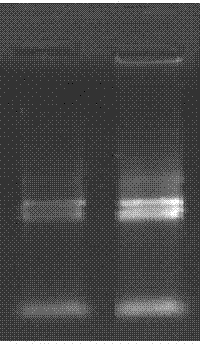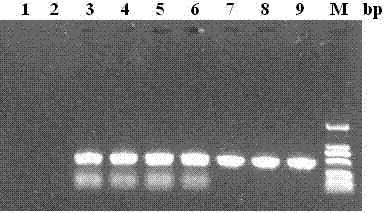Method for extracting scylla paramamosain reovirus RNA (Ribose Nucleic Acid) at room temperature
A technology of reovirus and pseudo-cave crab, which is applied in the field of viral RNA extraction, can solve the problems of unfavorable operation, time-consuming, and increased research costs, and achieve the effect of short cycle, simple operation, and high-quality RNA
- Summary
- Abstract
- Description
- Claims
- Application Information
AI Technical Summary
Problems solved by technology
Method used
Image
Examples
Embodiment 1
[0045] Viral RNA extraction
[0046] 1. Treatment of experimental supplies and preparation of medicines
[0047] (1) Handling of experimental supplies
[0048] The measuring cylinders, reagent bottles, tweezers and other glass utensils used in the experiment were baked continuously at 180°C for 10 hours; plastic centrifuge tubes and pipette tips were soaked in 0.1% DEPC water overnight and then sterilized at 120°C for 50 minutes; Materials related to isoelectrophoresis were soaked in hydrogen peroxide overnight.
[0049] (2) Experimental drug preparation
[0050] ACD anticoagulant: 82 mmol / L glucose, 23 mmol / L citric acid, 45 mmol / L sodium citrate
[0051] 75% Ethanol: Prepared with DEPC treated water
[0052] Chloroform:isoamyl alcohol (24:1)
[0053] 2. Acquisition of experimental materials
[0054] The blue crabs with typical "lethargy" and other symptoms of reovirus infection were selected as the research objects. Before sampling, soak the sick crabs with th...
Embodiment 2
[0065] Detection of RNA Quality by Amplification of Reovirus VP11 Region
[0066] 1. One-strand cDNA synthesis
[0067] Using the total RNA obtained in Example 1 as a template and the random primer N9 as a primer, reverse transcription was performed using reverse transcriptase from TaKaRa Company, and the first-strand cDNA was synthesized according to the instructions. The specific operations were as follows:
[0068] Prepare the reaction system according to the table below:
[0069]
[0070] After mixing the above reagents, place at 30°C for 10 min, react at 42°C for 2 h, keep at 95°C for 5 min, and briefly centrifuge to obtain the first strand of cDNA.
[0071] 2. Amplification of the VP11 region of the respiratory virus
[0072] The nested outer primers MCRVF (5'-TTCATTGGCATCCTGACTTT-3') and MCRVR (5'-TTCATTTGGTGAGC
[0073] CTTTGC-3'), the target fragment size is 433 bp, inner primers MCRVNF (5'-ACCTGATTATCGACCCAATCCCA-3') and MCRVR (5'-AGCCTTTGCCTGATGAGCCTGA...
PUM
 Login to View More
Login to View More Abstract
Description
Claims
Application Information
 Login to View More
Login to View More - Generate Ideas
- Intellectual Property
- Life Sciences
- Materials
- Tech Scout
- Unparalleled Data Quality
- Higher Quality Content
- 60% Fewer Hallucinations
Browse by: Latest US Patents, China's latest patents, Technical Efficacy Thesaurus, Application Domain, Technology Topic, Popular Technical Reports.
© 2025 PatSnap. All rights reserved.Legal|Privacy policy|Modern Slavery Act Transparency Statement|Sitemap|About US| Contact US: help@patsnap.com



